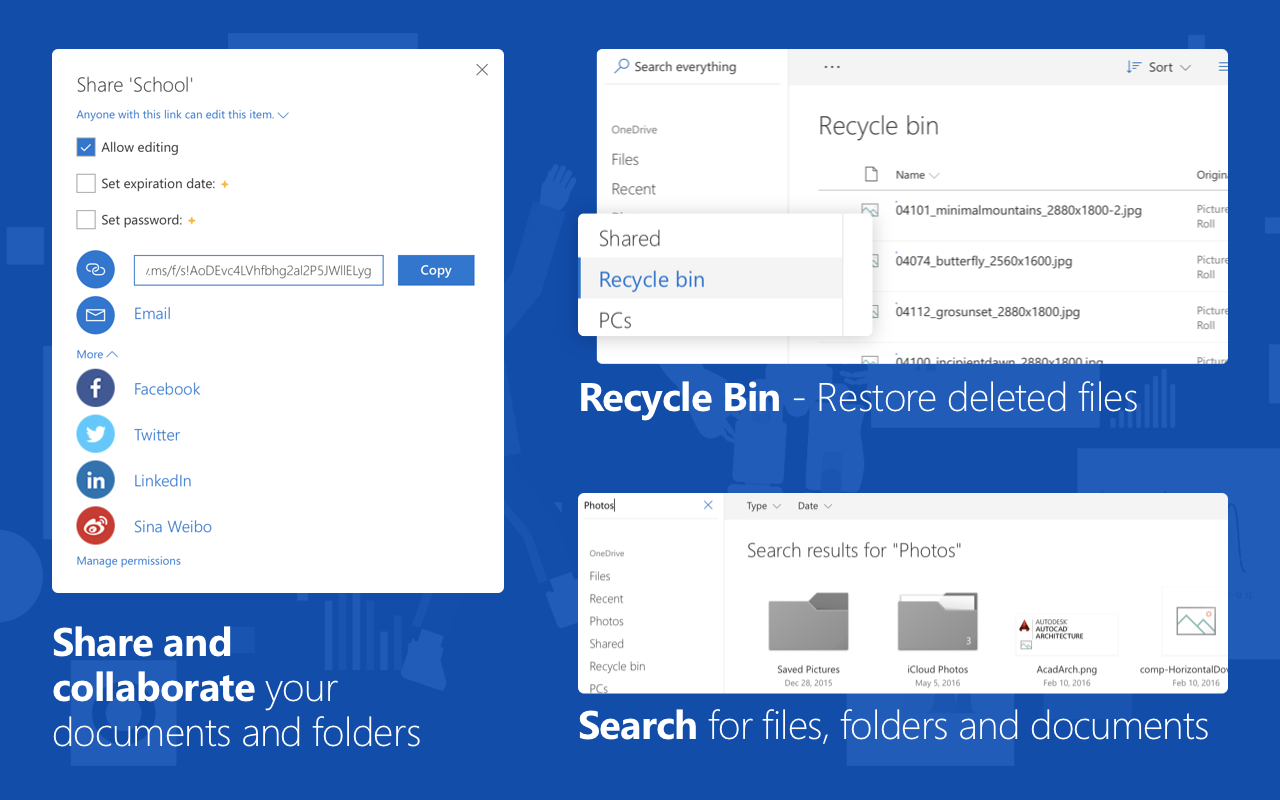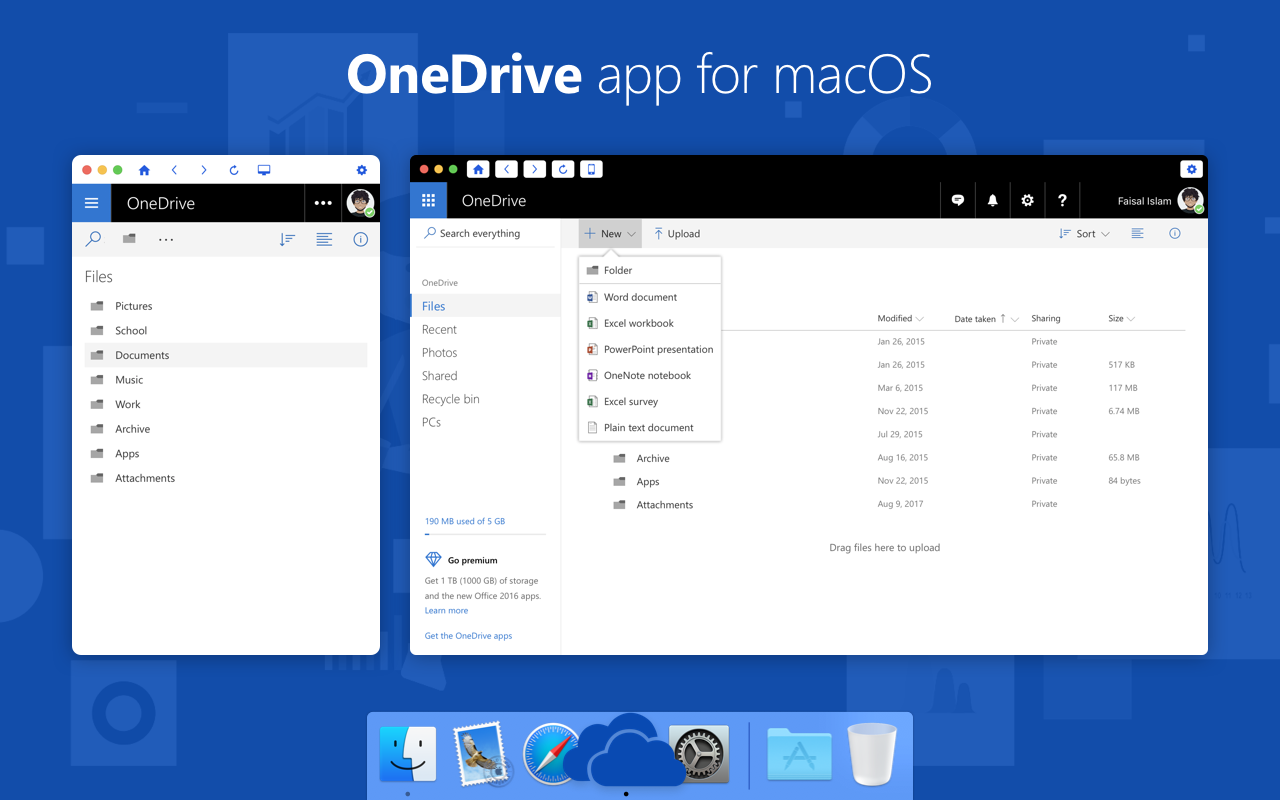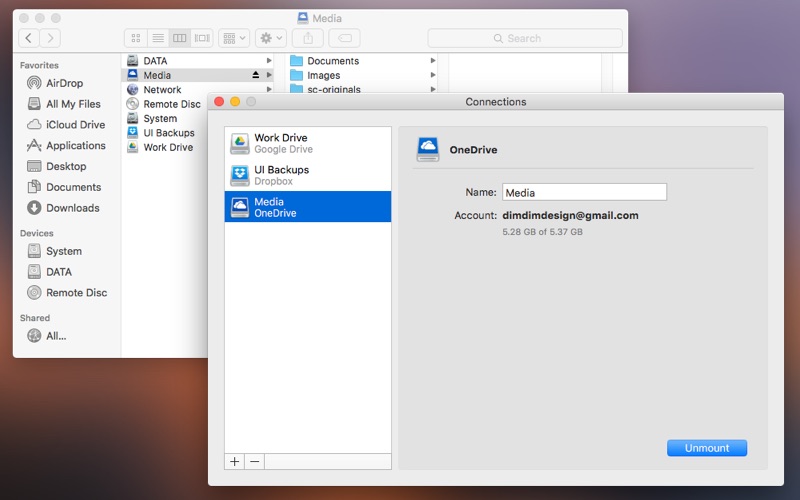| 2019 |
- Onedrive For Mac Client - Video Results
- Save Disk Space With OneDrive Files On-Demand For Mac ...
- See Full List On Docs.microsoft.com
Download OneDrive for Mac (standalone.pkg) - Version 20.143.0716.0003 (August 20, 2020) Also available from the Mac App Store. Bug fixes to improve reliability and performance. New features gradually rolling out to users.
- Onedrive For Business Mac Client Download Nov 20, 2017 If you run OneDrive for Business on a Mac, see Get started with the new OneDrive sync client on Mac OS X. This article contains information that applies when you use the OneDrive for Business sync client (groove.exe).
- Even though you can upload, download, and interact with your OneDrive files from a web browser, the ideal OneDrive experience comes from the Windows and Mac sync apps and the iOS and Android mobile apps. OneDrive is available for most operating systems and browsers and requires minimal hardware.
OneDrive for Business is part of Office 365 and offers the ability to store files in the cloud, access them from multiple computers, and share them with others. Accessing OneDrive for Business using a Mac can accessed on a college owned device by downloading and installing the client at:
1. Download the sync client from the app store. |
2. Search for OneDrive and then click on get. |
Setup:
With OneDrive app closed run the appropriate terminal commands on this Microsoft Support page.
Then follow the steps below:
1. Launch the program by double clicking on the OneDrive open command. |
2. Click through the Get Started to begin the sync with the computer. |
| 3. Enter your MCCC email address for the user name and your MCCC password |
5. Click Choose OneDrive for Business Folder Location Automatically open at log in and show/hide the dock icon |
6. Click and uncheck Open at login to prevent the client from opening at startup. Click and uncheck Hide Dock icon to remove it from the dock |
| 7. Choose the location for your OneDrive for Business folder (by default it will create it in the documents folder) |
8. The next screen will confirm the path you have chosen for the location of the OneDrive for Business folder. |
This completes the set up process you will now see a OneDrive Business folder under your favorites within finder.
NOTE: The OneDrive app requires Mac OS X 10.7.3 (Lion) or later.
What does the OneDrive folder do?

When you install the OneDrive app for Mac, a copy of your OneDrive is downloaded to your Mac and put in the OneDrive folder. This folder is kept in sync with OneDrive. If you add, change, or delete a file or folder on the OneDrive website, the file or folder is added, changed, or deleted in your OneDrive folder and vice versa.
To upload files to OneDrive automatically, just copy or move the files to your OneDrive folder using the Finder, or save them in your OneDrive folder from an app. Files you upload this way can be up to 10 GB in size. If you installed the OneDrive app on other computers, the files will automatically be added to the OneDrive folders on them, too.
You can also use the Finder to rename and delete files, create new folders, and move files around in your OneDrive folder. The changes will automatically be made in OneDrive and your other computers that have the OneDrive app installed.
TIPS
To rotate photos in OneDrive, open them in Preview, rotate them, and then save them. The photos will be automatically updated in OneDrive.
If you use a lot of storage space in OneDrive, it might take a long time to download all your files when you first install the OneDrive app. For tips on maximizing the transfer speed, see Maximize upload and download speed.

Onedrive For Mac Client - Video Results
Do I have to install the OneDrive app on all of my computers?
No. If you don't want to keep all the files in your OneDrive on a computer, you can still work with your OneDrive on that computer by going to the OneDrive website.
Why do I have to confirm my OneDrive folder on my Mac?
OneDrive is following recommendations from Apple that Mac OS X apps have sandboxing. With sandboxing, the OneDrive app will access only the files it needs on your Mac. This means we need to ask you to confirm the location of your OneDrive folder. If you select any folder other than your current OneDrive folder, you'll have to go back through setup and re-download the contents of your OneDrive. To learn more about app sandboxing, search the Apple website.
How do I show or hide the OneDrive app icon in the Dock?
The OneDrive app icon is hidden by default. To show it in the Dock, click to deselect the Hide Dock iconcheckbox in Preferences.
Can I choose folders in my OneDrive that I don't want to sync on my Mac?
Yes. When you first set up OneDrive, click Choose folders to sync. If you didn't do this when you set up OneDrive, you can do it in Preferences:
Click the OneDrive icon in the menu bar.
Click Preferences, click the Choose Folders tab, and then click Choose Folders.

For each folder, you can choose to sync everything in the folder, individual folders within the folder, and files that aren't in any subfolders within the folder. If you choose to sync only some items, new items you add to the OneDrive folder on your Mac will sync to OneDrive, but items you add to OneDrive from the website or other devices won't be synced to your Mac unless they're in the folders you chose to sync. If you choose to stop syncing folders on your Mac, they'll be deleted from the OneDrive folder on that computer, but they'll remain in OneDrive.
NOTE: You can't choose individual files you want to sync, and you can't choose to sync files or folders shared with you.
Can I change the name or location of my OneDrive folder?
No, you can't currently do this. If you use the Finder to rename or move your OneDrive folder, OneDrive will stop working.
Can I use OneDrive to get to files and folders on my Mac that aren’t saved in my OneDrive folder?


No, the Fetch files feature is available only on PCs. This also means you can't stream videos that are on a Mac from the OneDrive website.
Can I change the account I use with OneDrive?
You can change the account you use with OneDrive, but you can't use the folder with multiple accounts at the same time. To change the account you use with OneDrive, choose Sign Out from the menu bar.
Can I recover files or folders I deleted?
Check the Trash for files you deleted from the OneDrive folder on your Mac.
How do I uninstall the OneDrive app?
Just drag the OneDrive app to the Trash.
-->When you deploy SharePoint Server 2019 in your organization, your users can sync their OneDrive files as well as SharePoint team site files by using the new OneDrive sync app (OneDrive.exe) for Windows or Mac. Compared with the previous OneDrive sync app (Groove.exe), the new sync app provides:
- Improved performance and reliability
- Files On-Demand
- Support for larger files
- Higher sync limits
- The ability to silently deploy. If your Windows users are already syncing document libraries with the previous OneDrive sync app, they will transition to the new sync app automatically.
- Mac support
Requirements
Install SharePoint Server 2019.
Install the OneDrive sync app (download). For deployment info, see:
Configure OneDrive for SharePoint Server 2019.
Recommendations
1. Allow WNS Traffic
For the best user experience, SharePoint Server 2019 will send change notifications to sync clients via WNS web push notifications. This feature ensures sync users quickly have the latest copies of any SharePoint Server file updates. You may need to take steps to ensure outbound requests from your SharePoint Server and your user's sync client computers can reach and properly interact with the WNS service.
For SharePoint Server:
- Allow outbound HTTPS connection to reach *.notify.windows.com
For OneDrive Sync client computers:
- Allow outbound TLS encrypted TCP/IP socket connection to reach *.wns.windows.com
- Avoid HTTPS decryption for *.wns.windows.com on your proxy server as this likely will disconnect the socket connection.
If either the SharePoint Server or the OneDrive sync client is unable to communicate with the WNS service then the sync client will fall back to polling the SharePoint Server roughly every two minutes looking for changes. As a result, your users may see delays of more than two minutes from the time of a server change to when the sync client downloads the changed file.
2. Opt-in to Sharing Improvement Information
When configuring the SharePoint server you have the option to enable sharing of improvement information with Microsoft. Enabling this opts connected sync clients into sending troubleshooting information. This allows the sync client team to proactively detect and correct problems, respond to customer reported problems, and improve the product over time. If this is disabled, customer escalations are harder to investigate and will require the customer to manually gather and provide logs from the impacted sync client machines.
Configure OneDrive for SharePoint Server 2019
To set up OneDrive with SharePoint Server 2019, you can either use Group Policy or set the registry keys directly.
Note
For settings that require an organization ID, if you sync a single domain, you can use OP1. Do not use this if you sync multiple domains.
The Known Folder Move settings don't work for SharePoint Server.
Using Group Policy
Configure the following two Group Policy objects to configure OneDrive to be used with SharePoint 2019:
Specify SharePoint Server URL and organization name
The URL (SharePointOnPremFrontDoorUrl) is used by the sync app to authenticate the user and to set up syncing of the user's SharePoint Server hosted personal OneDrive site.The organization name (SharePointOnPremTenantName) lets you specify the name of the root folder that will be created in File Explorer. If you don't supply an organization name, the sync app will use the first segment of the URL as the name. For example, office.sharepoint.com would create the folder 'office'.
Specify the OneDrive location in a hybrid environment
This setting (SharePointOnPremPrioritization) lets you specify if the sync app should first set up a sync relationship with SharePoint in Microsoft 365 (the default) or the SharePoint on-premises server if the user identity exists in both identity providers. The sync application's Settings dialog can be used to 'Add Account' the same identity for the other SharePoint realm after the first has been configured (if the user identity exists in both).
You should be able to find these Group Policy objects using the Group Policy Editor (gpedit.msc) when navigating to Computer ConfigurationAdministrative TemplatesOneDrive. If the OneDrive folder is not present, you can add the OneDrive Group Policy template by copying the following two files from the OneDrive installation folder after you have installed the latest OneDrive sync app on that computer:
- C:UsersusernameAppDataLocalMicrosoftOneDriveonedrivesyncclientversionadmOneDrive.admxtoC:WindowsPolicyDefinitionsOneDrive.admx
- C:UsersusernameAppDataLocalMicrosoftOneDriveonedrivesyncclientversionadmOneDrive.admltoC:WindowsPolicyDefinitionsen-USOneDrive.adml
To automate this copying using PowerShell, you could use:
More information:Learn how to manage OneDrive using Group Policy
By setting the registry keys
Alternatively, you can also directly configure the following underlying registry keys:
| Key | Type | Value | Required |
|---|---|---|---|
| HKLM:SoftwarePoliciesMicrosoftOneDriveSharePointOnPremFrontDoorUrl | String | https://sharepoint.contoso.local | required |
| HKLM:SoftwarePoliciesMicrosoftOneDriveSharePointOnPremPrioritization | DWORD (32-bit) | 1 | optional |
| HKLM:SoftwarePoliciesMicrosoftOneDriveSharePointOnPremTenantName | String | Contoso | optional |
Differences between syncing files in SharePoint Server and SharePoint in Microsoft 365
If your organization also uses the OneDrive sync app to sync files in Microsoft 365, here's what will be different for users who sync on-premises files.
Single Top-level URL
Save Disk Space With OneDrive Files On-Demand For Mac ...
If you have deployed multiple on-premises SharePoint Server farms in your enterprise, on a given client computer, you will only specify a single 'SharePointOnPremFrontDoorUrl'. For a given user, you should configure their computer with the SharePoint Server URL that hosts their individual OneDrive site or if they don't have a OneDrive site, where the team sites they are most likely to sync are hosted. Your users will be able to start syncing team site content from any of your on-premises SharePoint Server farms by navigating to the web experience of the Team Site and clicking the Sync button on that site.
For example, you have a SharePoint Server farm for your Finance department and another for the rest of your company. Users who are members of the Finance department have their individual OneDrive site hosted on the Finance department's SharePoint Server farm. For those Finance employees, you use your computer management system to set the SharePointOnPremFrontDoorUrl registry key policy on their computer to have your Finance specific farm's URL. For all other employees, you set the SharePointOnPremFrontDoorUrl to your other SharePoint Server farm URL. The sync client will look for and provision on-demand as needed, the user's OneDrive site on the appropriate SharePoint Server farm.
Folder names
The OneDrive sync app creates the following folders on users' computers:OneDrive – Contoso (for syncing personal My Site files)Contoso (for syncing SharePoint team site files)
In SharePoint in Microsoft 365, 'Contoso' is the tenant name that has been set for the SharePoint in Microsoft 365 instance. In SharePoint on-premises, there is no tenant name associated to the instance of SharePoint. You can set the this with the 'Specify SharePoint Server URL and organization name' group policy, or the sync app will use the first segment of your SharePoint URL.
File thumbnails and previews
Thumbnails don't appear in File Explorer for files synced from SharePoint on-premises. If you enable Files On-Demand, and a file is online-only, a file preview won't be available. Image files and Office files will not have a thumbnail in File Explorer until the file is downloaded.
Sharing from File Explorer
When users share files and folders from File Explorer, the sharing option will open the browser instead of the Share dialog.
Privacy settings
When setting up SharePoint Server, you'll be prompted to select if clients should send error reports and usage statistics back to Microsoft. If you enable the setting, individual users can opt out by following these steps:
See Full List On Docs.microsoft.com
At the far right of the taskbar, in the notification area, right-click the OneDrive cloud icon.
Select Settings.
Select the Settings tab, and under Privacy, clear the option.
